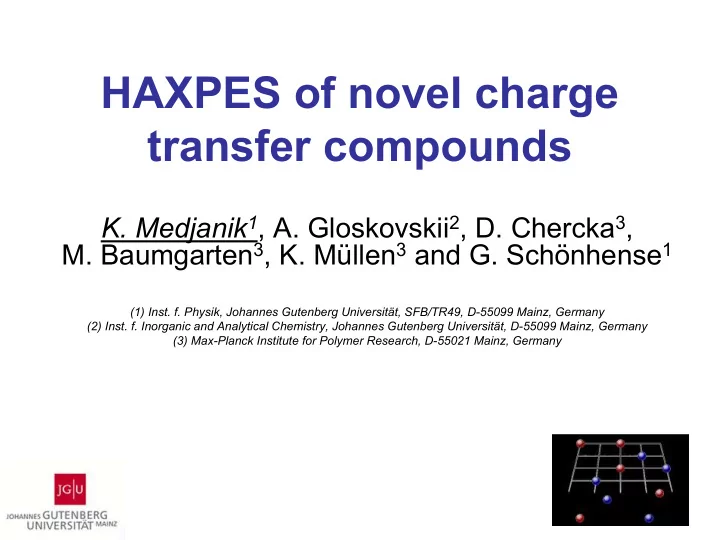

HAXPES of novel charge transfer compounds K. Medjanik 1 , A. Gloskovskii 2 , D. Chercka 3 , M. Baumgarten 3 , K. Müllen 3 and G. Schönhense 1 (1) Inst. f. Physik, Johannes Gutenberg Universität, SFB/TR49, D-55099 Mainz, Germany (2) Inst. f. Inorganic and Analytical Chemistry, Johannes Gutenberg Universität, D-55099 Mainz, Germany (3) Max-Planck Institute for Polymer Research, D-55021 Mainz, Germany
Outline 1. Introduction 2. Behaviour at metal-organic interface 3. HAXPES results on charge transfer salts Functionalized polycyclic aromatic hydrocarbons (PAHs) this talk Organic (super-) conductors (kationic radical salts) Poster # 35 4. Summary and Conclusions
Motivation • Search for novel charge transfer (CT) complexes with designed donor and acceptor molecules • Explore UHV-codeposition for the production of compounds that cannot be grown from solution • Systematic study of changes of the electronic structure upon formation of CT complexes • First HAXPES-results for such CT compounds
Charge transfer complexes Electron donor The total energy per donor-acceptor pair TMP E ( d q)= (E D aff ) d q - a (e 2 /a)( d q) 2 ion - E A d q TCNQ HMP-TCNQ Electron acceptor
UHV co-deposited thin films of TMP-TCNQ-complex Optical microscope AFM 10 m m Dark-looking crystallites: higher absorption in the visible d q TCNQ TMP C 24 H 12 N 4 C 20 H 18 O 4 K. Medjanik et al., Phys. Rev. B 82 (2010) 245419
UHV co-deposited thin films of TMP-TCNQ-complex d q Tetramethoxy -Pyrene TMP C 20 H 18 O 4 TCNQ C 24 H 12 N 4 K. Medjanik et al., Phys. Rev. B 82 (2010) 245419
HAXPES on thin films of TMP-TCNQ-complex TMP + TMP 0 e - O1s Oxygen 1s HAXPES core level spectra for a co-deposited thin film of the CT complex TMP-TCNQ grown in UHV (a), together with the spectrum of a thin film of pure donor material TMP (b).
Mixed-stack arrangement (from XRD) Neutral donor in complex TMP 0 Neutral acceptor in complex Ionic donor + d q TMP + - d q Ionic acceptor No band-formation but local dimers, unlike k -systems (Poster #35)
HAXPES on thin films of TMP-TCNQ-complex Pure TMP: TMP + TMP 0 B + + B D C 26% Relative abundance of ionic TMP in complex: C + D C e - 61% O1s Oxygen 1s HAXPES core level spectra for a co-deposited thin film of the CT complex TMP-TCNQ grown in UHV (a), together with the spectrum of a thin film of pure donor material TMP (b).
Microcrystals of same complexes grown from solution CT-complexes HMP - TCNQ ( HMP x -TCNQ y , X:Y=1:1, 1:2, 2:1) Grown via vapour diffusion HMP CT complex 1mm TCNQ Optical microscopy d q HMP TCNQ C 22 H 22 O 6 C 24 H 12 N 4
Relative abundance Pure HMP: HMP + HMP 0 of ionic HMP in complex: C B + D C + + B D C 64% 20% 63% 42% e - 34% 73% O1s HMP Oxygen 1s HAXPES core level spectra for three microcrystal fractions of the CT complex HMP-TCNQ grown in solutions with stoichiometries HMP x :TCNQ y (X:Y= 1:2, 2:1, 1:1) together with the spectrum of pure donor material HMP.
Summary and Conclusions • HAXPES core level spectra avoid the problem of surface preparation for solution-grown organic crystals. • Oxygen 1s signal provides a local spectroscopic probe at donor (Oxygen is only contained in the methoxy group). • The degree of charge transfer in HMP x -TCNQ y (x:y=1:1, 1:2, 2:1) microcrystals and TMP-TCNQ thin films is about 0.65.
Thanks: Institut für Physik, Johannes Gutenberg- Universität, Dmytro Kutnyakhov, Sergej Nepijko, Hans-Joachim Elmers Institut für Analytische und Anorganische Chemie, J. Gutenberg- Universität (theory) Shahab Naghavi, Claudia Felser DESY, Hamburg Wolfgang Drube, Sebastian Thiess, Heiko Schulz-Ritter In the framework of Transregio SFB TR49 (Frankfurt, Mainz, Kaiserslautern) And Graduate School of Excellence MAINZ
Thank you!
Dependence of the HOMO and LUMO positions and the gap on the intermolecular distance for HMP and TCNQ sandwiched in different local configurations dashed line denotes the interlayer spacing in HMP-TCNQ as determined from X-ray diffraction Gaussian 03 with B3LYB hybrid functional
TCNQ C 24 H 12 N 4 N 1s region high-resolution X-ray photoelectron spectra of TCNQ. John M. Lindquistt and John C. Hemminger, J. Phys. Chem. 92 (1988) 1394-1396.
TCNQ 0 TCNQ - Relative abundance of ionic TCNQ in Pure TCNQ: complex: 40% 33% e - 69% 22% N1s Nitrogen 1s HAXPES core level spectra for two fractions of solution- grown microcrystals of the CT complexes HMP x :TCNQ y (X:Y= 1:2, 1:1) (a,b) together with the spectrum of the pure acceptor material TCNQ (c).
Organics-based Organic LEDs flexible display
Figure Energy scheme of the photoemission transitions observed . i > and f > denote the initial states and the final states.
IR-spectra Formation of the complex softens the CN – vibration Mode [3,4]. 7cm -1 red shift CN vibration Top: CN stretching vibration in a TCNQ film on Au Bottom: Same for the mixed phase TCNQ - TMP on Au at low coverage Centre: Same at higher coverage (evidence of coexistence with pure TCNQ phase) {3] D. L. Harms, Anal. Chem. , 1953, 25 (8), 1140-1155 [4] X. Chi et al., Chem. Mater. , 2004, 16 , 5751 K. Medjanik et. al., Phys. Rev. B 82 (2010) in print
Recommend
More recommend